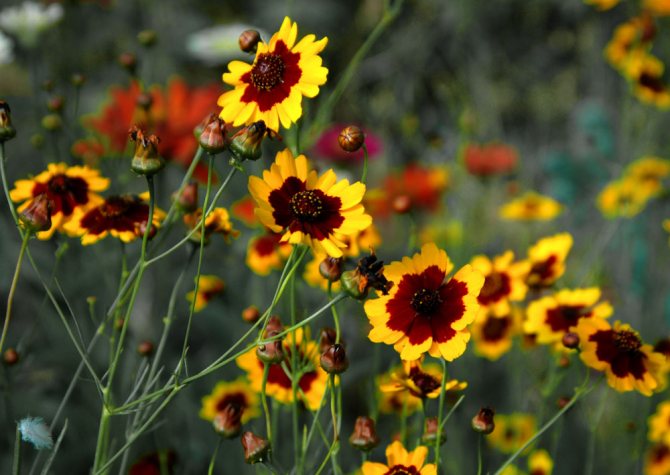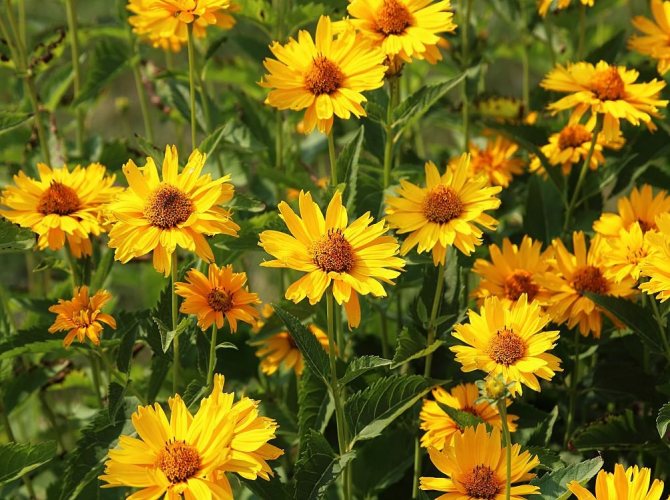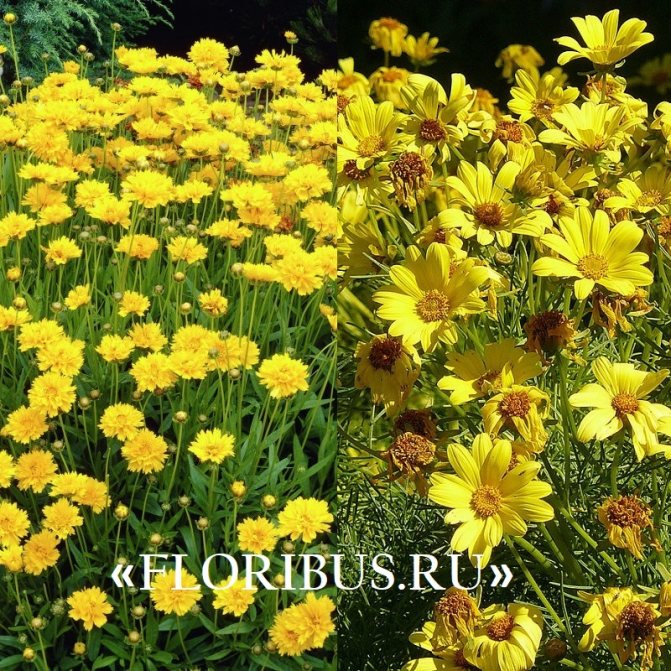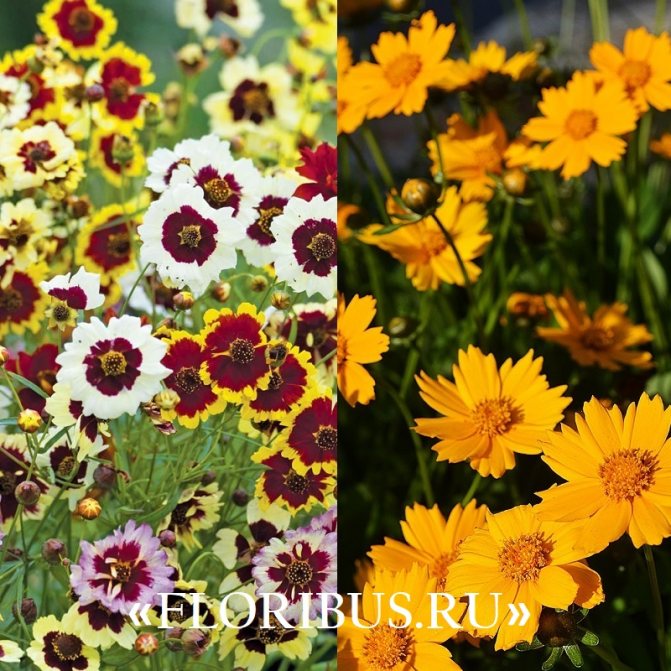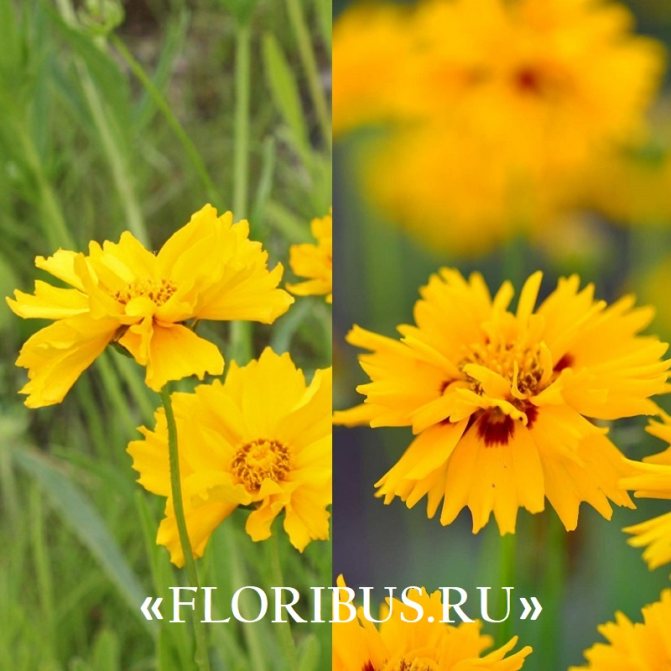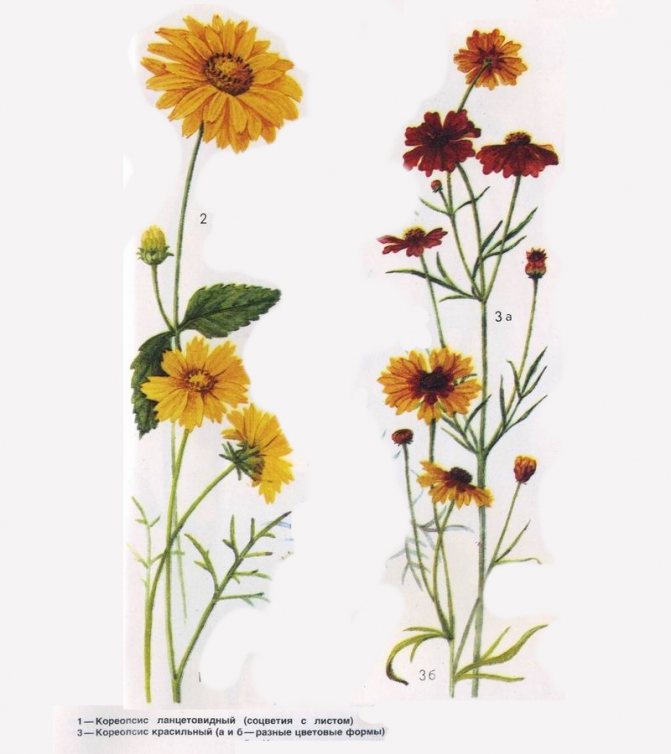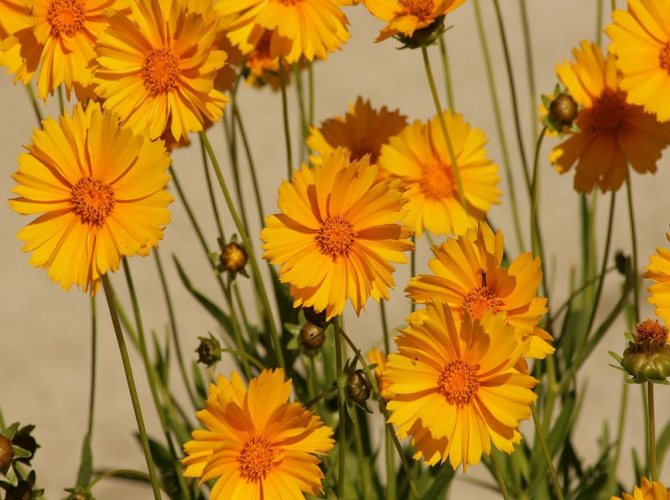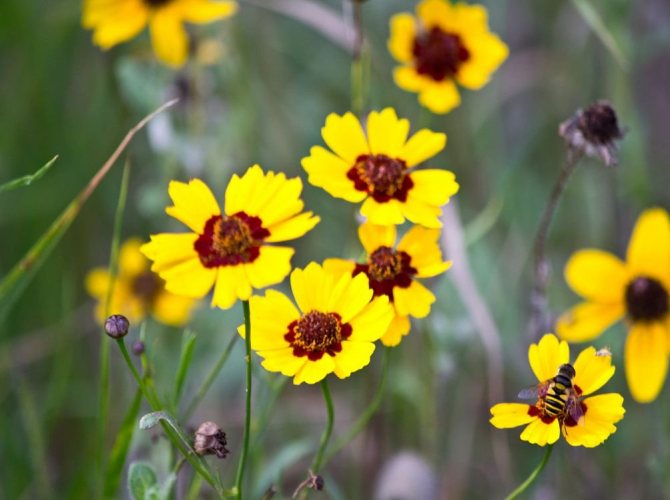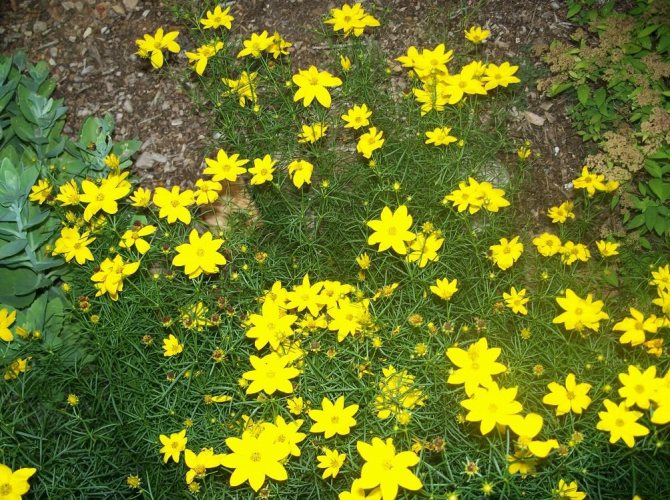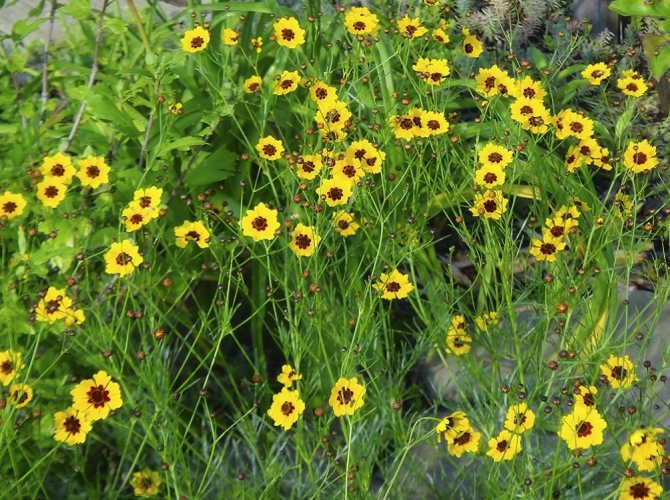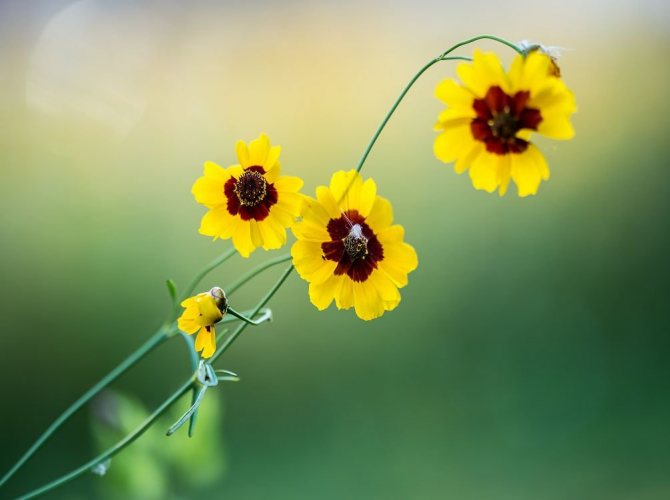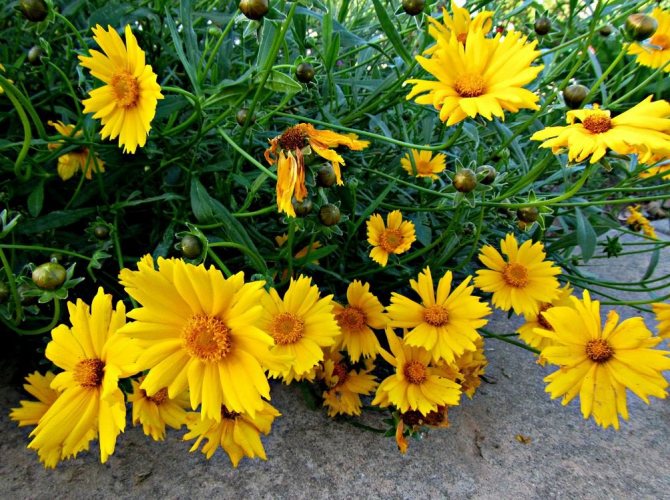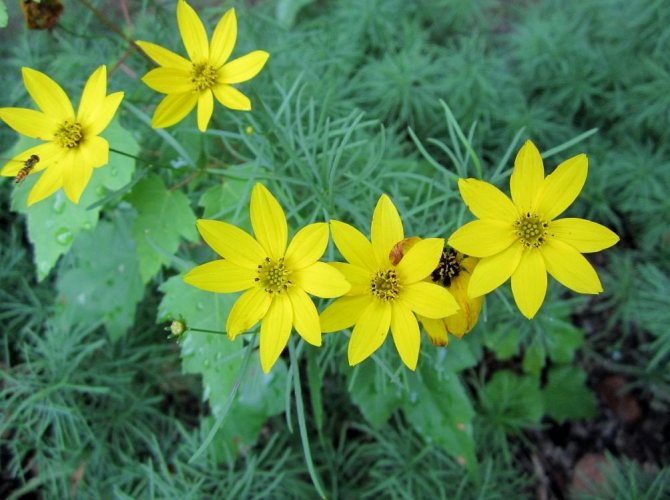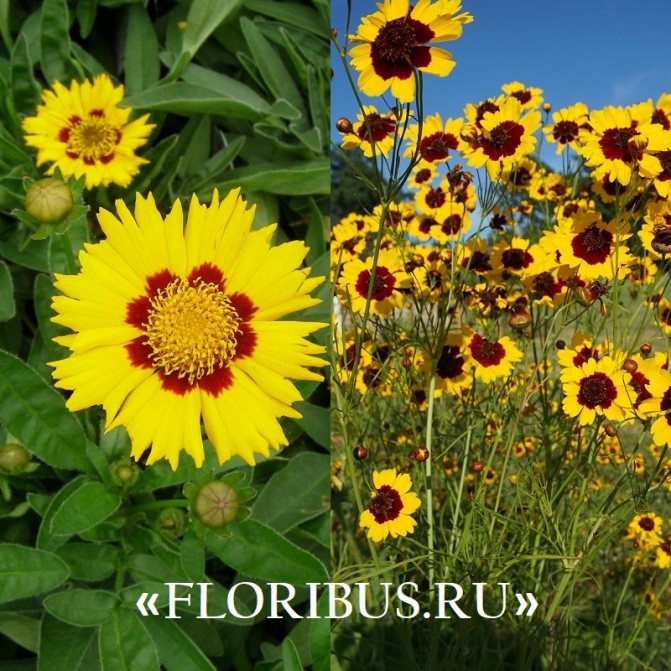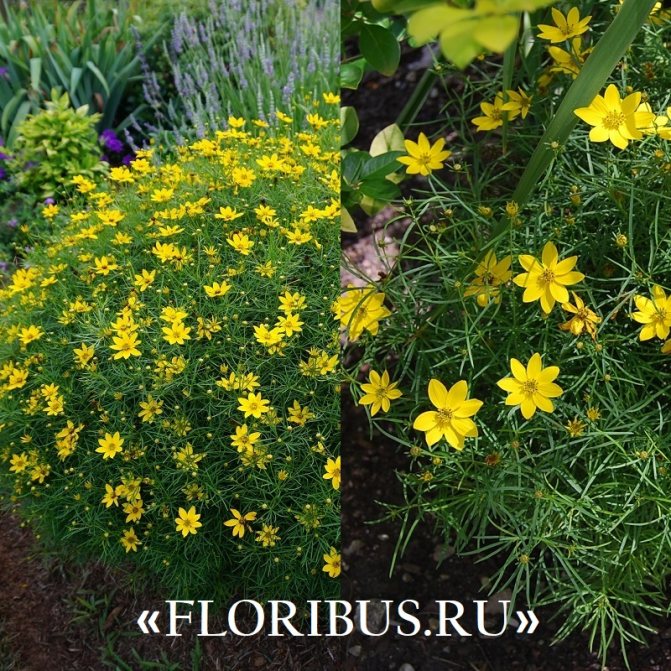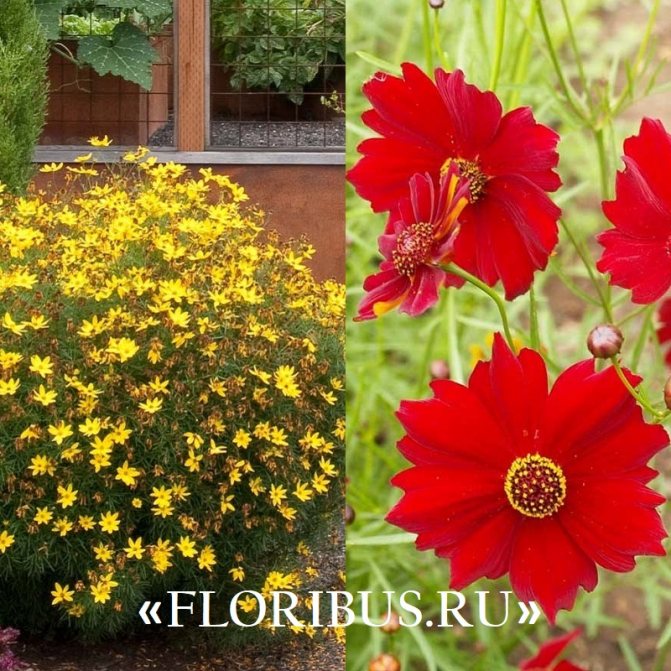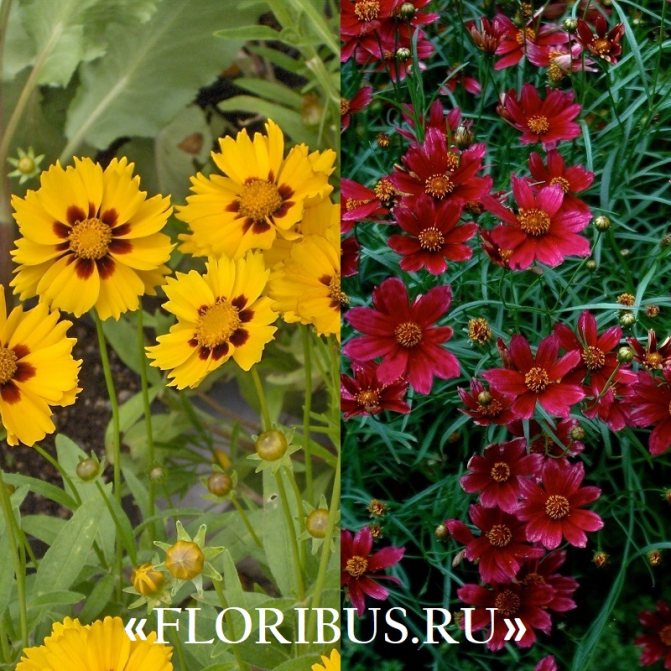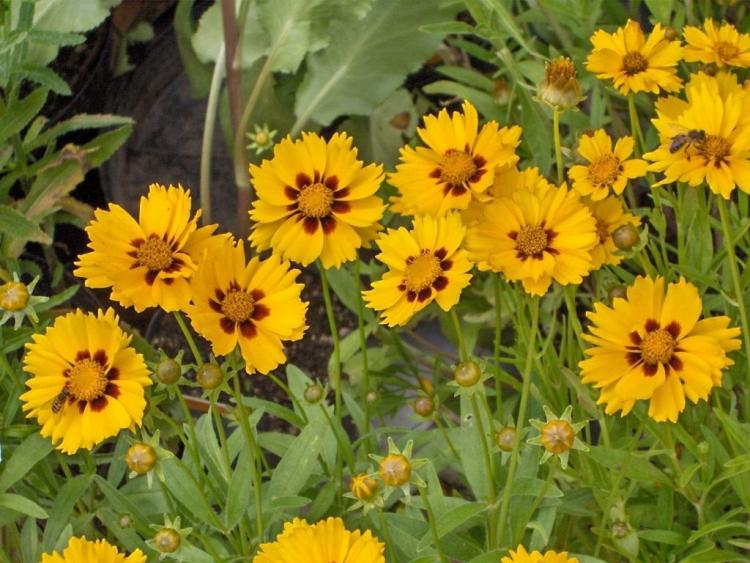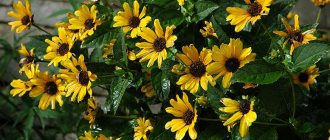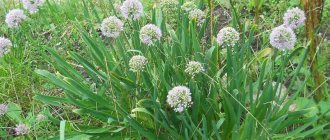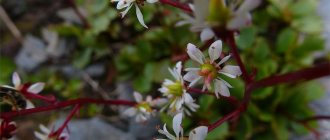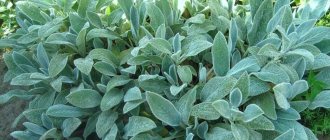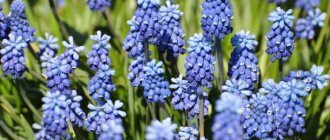"The sun in the garden" - so lovingly christened flower growers coreopsis.
This flower resembles a chamomile, but bright yellow, incredibly hardy and filling everything around with warm comfort.
A perennial (often grown as an annual) plant will calmly survive the lack of moisture and will delight with flowering before the onset of frost. For those wishing to grow coreopsis outdoors, planting and grooming will not turn into a problem.
Coreopsis is a bushy guest who came to us from the vastness of tropical Africa, North America and the Hawaiian Islands, where he lives in the forests and decorates the meadows with a bright carpet.
The plant is herbaceous, the stems reach 45 and even 90 cm in length, and the diameter of beautiful flowers is on average 6 centimeters.
However, there are more than a hundred species and each is good in its own way.
The origin of the plant
Coreopsis is also called the Parisian beauty. These are annual or perennial flowering herbaceous plants belonging to the Asteraceae family (in Latin Asteraceae). They come from the cool and dry regions of North America, where they grow wild in the sands and prairies. Today, science knows about 100 species of coreopsis.
Large-flowered coreopsis (Coreopsis grandiflora) grows wild in North America, is grown around the world as an ornamental plant. Quite often it can be found in our gardens, where it is grown as a short-lived perennial plant, sometimes regarded as an annual plant. The large-flowered species owes its popularity to the bright yellow flowers that appear from June to September. Plants bloom very profusely and will decorate any perennial bed.
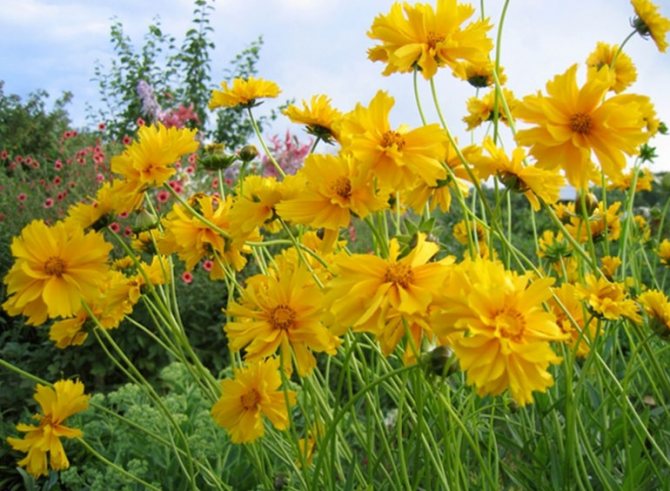
You can start growing coreopsis by sowing seeds and preparing seedlings yourself. To do this, you can use pots with a diameter of 9-10 cm in which the plants are grown alone, or large ones - 13-15 cm, in which 3 copies are placed. For cultivation in a pot, a permeable substrate with a pH of 5.8-6.4, containing peat and clay, is chosen. At the end of spring, one-year seedlings obtained in pots from cuttings are transplanted into the soil.
The best varieties of coreopsis with photos and names
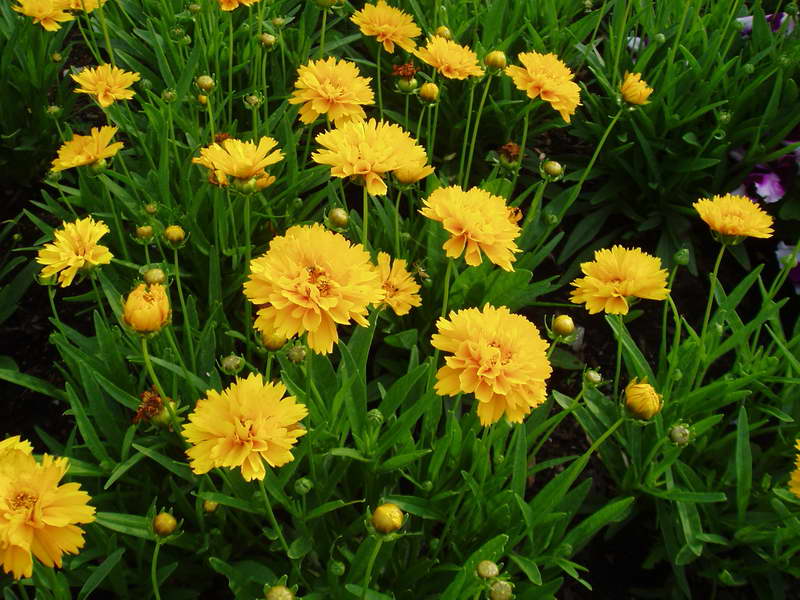

Coreopsis large-flowered terry airlie sunrise Coreopsis Early Sunrise photo
Earley Sunrise has a special charm: full, dense double flowers cover the bush with a yellow cloud. bushes are low, compact.
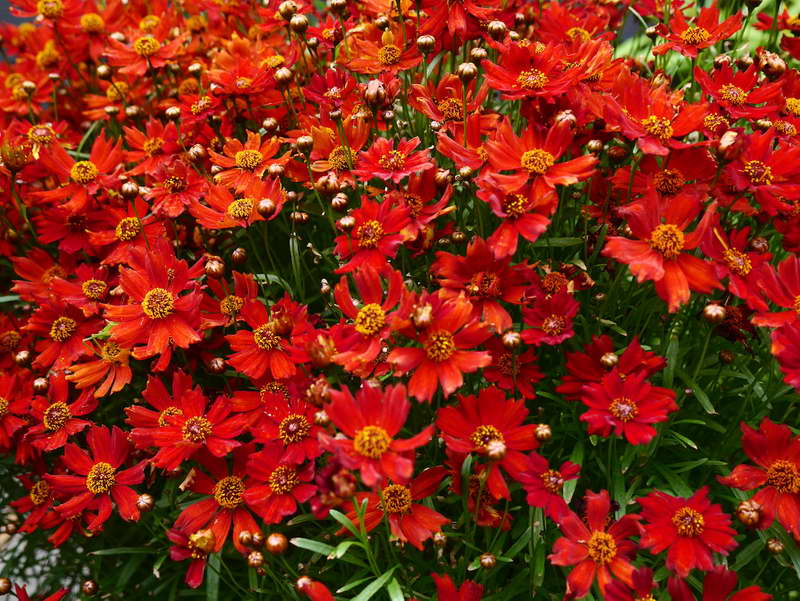

Coreopsis dye amulet amulet photo
The flowering of the Amulet variety resembles a blazing fire: bright scarlet flowers cover dense bushes with a solid carpet. The variety is effective both in mono-plantings and in contrasting combinations with other flowers.
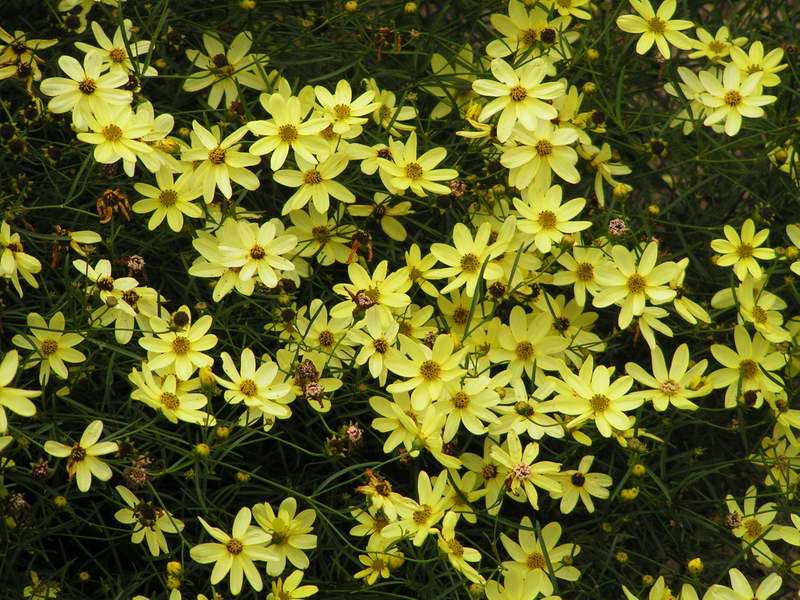

Coreopsis yellow moonbeam photo
Delicate yellow flowers of the moonbeam variety captivate with delicate charm, really resembling the shining of the moon or small stars scattered on the dark green carpet of leaves.
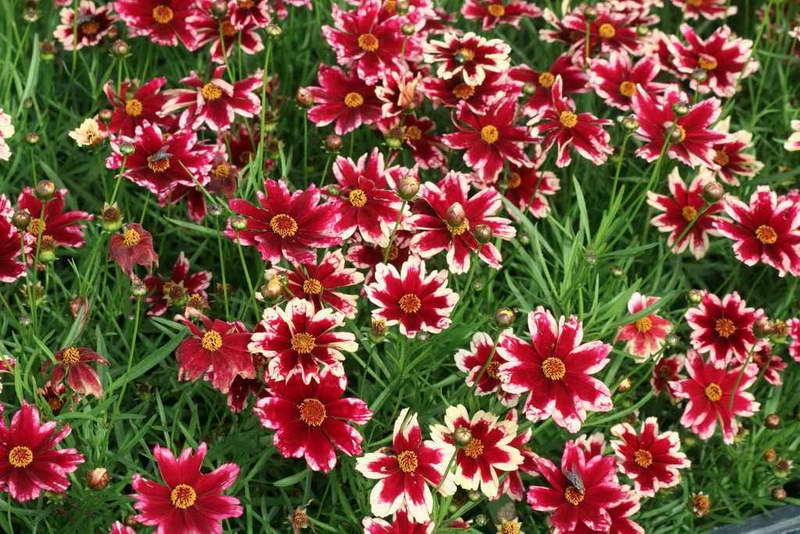

Coreopsis ruby frost Coreopsis ruby frost photo
Bright and showy: Ruby frost with deep red flowers with a white border around the edges of the petals. Abundant flowering, continuous.
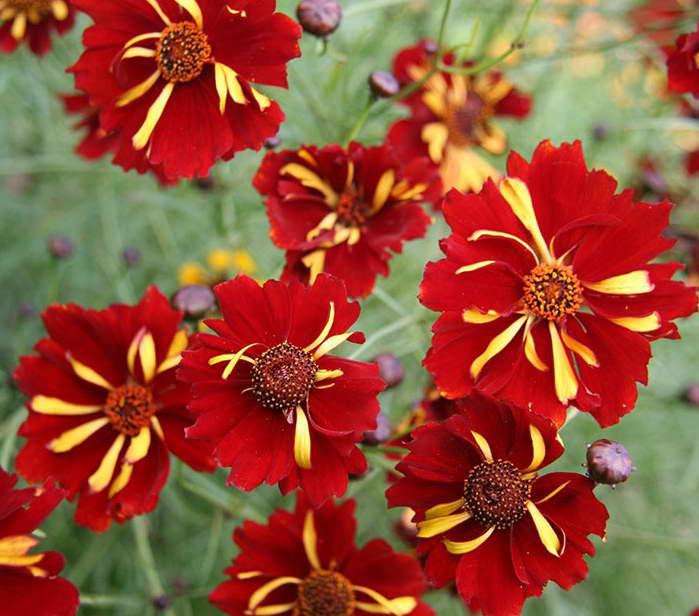

Coreopsis Sharman sharman photo
The Sharman variety is notable for its unusual combination of color and shape: on top of wide scarlet petals there is a row of thin bright yellow petals, resembling rare rays on a blazing crimson background.
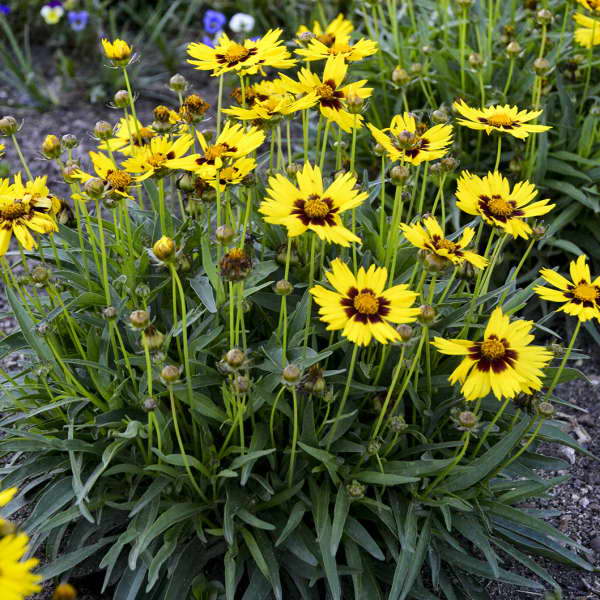

Coreopsis grandiflora San kiss Coreopsis grandiflora ‘SunKiss’ photo
The compact, powerful bush of the San Kiss variety is crowned with large bright yellow flowers with orange centers. The edges of the petals are split, which gives a special lightness to flowers that resemble fluttering butterflies.
Appearance
- Height and shape. Coreopsis can reach a height of 15 to 90 cm, there are tall and dwarf varieties. These short-lived perennials have pubescent stems that form rather sparse bushes. They can grow up to 60-70 cm wide.
- Leaves are bright green, lanceolate, oblong.
- Stems are thin, erect.
- Inflorescences. On the tops of the stems there are large flower inflorescences of the basket (hence the name "large-flowered"), 6-8 cm in diameter. Flowers have jagged edges. They can be single, semi-double or double (depending on the variety). Usually they are bright yellow in color, there are varieties that bloom with red or pink flowers.
- Flowering period. Large-flowered coreopsis bloom all summer - from late June to late August. If you systematically cut off the faded inflorescences, the plants can bloom again in the fall.


Description of the coreopsis flower
Coreopsis is a herb or shrub with highly branched and erect stems that grow from forty-five to one hundred and twenty centimeters in height. The leaves of the plant are opposite, pinnately dissected or finger-separated. The flowers are somewhat reminiscent of a chamomile flower. Price Venus has brown or yellow tubular flowers, and around the center there are tongue-shaped petals of pink, yellow or yellow-brown color. The fruit of the plant is the achene, which produces a large number of seeds.
Growing conditions
Coreopsis require extremely sunny and warm positions. Planted in the shade, they grow less and bloom less abundantly. Perennials grow in almost any medium soil, soils are better suited:
- fertile;
- rather loose;
- relatively wet.
Coreopsis is not picky about care, but does not like long-term drought, therefore, in hot weather, in the absence of rain, the plant needs regular watering. In too dry, sandy soil, they begin to bloom less, flowers are much smaller.


How to plant coreopsis in the ground
Choose an open, sunny area for the plant without moisture stagnation. Moderately fertile, loose soil is required. If the soil is heavy, clayey, add humus and coarse sand for digging.
- Make the holes according to the size of the root system.
- Transfer seedlings and rooted cuttings along with an earthen clod so as not to damage the roots.
- When planting, keep a distance of 25-30 cm between plants.
- Slightly compact the soil around the plant, water abundantly.
Transplant and divide the bush every 4-5 years.
Coreopsis care
- Pruning. Coreopsis blooms in summer, sometimes repeats flowering in autumn. In order to stimulate the plants to produce new flower buds, the faded buds must be trimmed systematically.
- Garter. Tall varieties of coreopsis can grow to a height of 80-90 cm. Such tall plants require support so that they do not break under their own weight.
- Wind protection. Coreopsis should grow in secluded places, protected from the wind, so that strong gusts do not break them.
- Winter care. Large-flowered coreopsis are completely frost-resistant plants that do not require additional shelter for the winter. The aboveground part of perennial plants should be left for the winter period - this will provide additional protection of the root ball from frost. Plants are pruned in the spring to the ground.
- Fertilizer. Coreopsis do not require intensive feeding - too frequent fertilization can lead to excessive leaf growth, weakening of flowering. It is enough to apply a multicomponent slow-acting fertilizer once during the growing season. The composition is introduced in the spring.
- Mulching such care is necessary, it prevents evaporation of water from the ground and the growth of weeds around the flower.
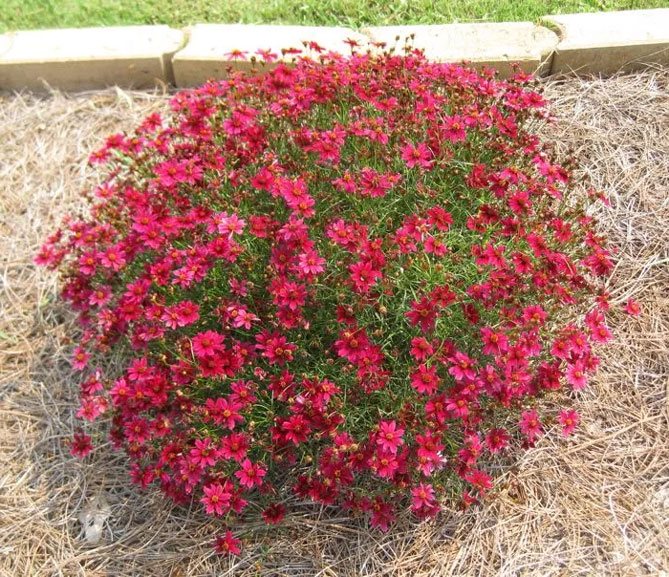

Care - how to grow properly
In order for coreopsis to delight you with its abundant flowering, you need to fully care for it.
Watering
If the amount of precipitation is not enough, then the coreopsis must be watered. During drought, perennial species, if they do not receive the required amount of moisture, simply stop blooming. Water regularly, but not too abundantly. Stagnant water can lead to root rot. You can also organize an irrigation system in the country from plastic pipes.
Top dressing
During the growing season, the crop must be fertilized. For this, it is necessary to make mineral fertilizing 3 times. But here you should not overdo it, as this will lead to an enhanced formation of green mass, but the flowering intensity will decrease. If this could not be avoided, then the plant will have to be destroyed, since it has forever lost its decorative qualities.
In the video - feeding flowers:
Wintering
When it comes to cold weather, cut the crop stems without leaving anything on the surface. In central Russia, it can stay for the winter. At the same time, you do not need to worry about any additional insulation structures. But in the northern regions, the plant must be protected. For wintering flowers, you can use a prefabricated greenhouse.
Pests and diseases
Coreopsis rarely succumbs to the influence of pests and diseases, but with insufficient care it can be struck by fungal ailments. It is impossible to fight them, so the culture will simply have to be removed. The plant can also be affected by aphids. On its leaves, you can find spots on the buds.
You can get rid of such a pest with the help of special preparations. Parasitic beetles can eat leaves. To eliminate them, you will have to use manual assembly.
Coreopsis is an ornamental plant, which today has begun to actively decorate flower beds and flower beds. This perennial crop can be an excellent neighbor for other plants, since it is completely picky in terms of care and does not interfere with the growth and development of other flowers.
We also recommend that you read in more detail about the cultivation of Turkish carnations.
Breeding methods, planting
Coreopsis are rather short-lived perennials, so it is worth updating the plantings every 3-4 years.
They reproduce in 3 ways:
- seeds;
- dividing the bush;
- reproduction of coreopsis by cuttings.
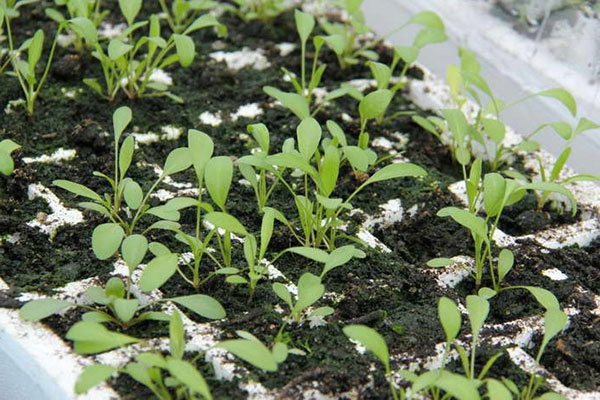

When coreopsis multiplies by dividing the bush, the plant is dug out immediately after flowering, the rhizome is divided into several parts with a knife and immediately planted in the ground.
You can start growing coreopsis by sowing seeds and preparing seedlings yourself. When propagating from seeds, it is advisable to purchase them in specialized garden centers. You can sow in spring or autumn (then they need to overwinter). When to plant seeds for seedlings depends on whether we can provide plants with a decent winter.
The choice of containers for sowing seeds:
- small pots with a diameter of 9-10 cm, in which the bushes are grown alone;
- large pots with a diameter of 13-15 cm, which can accommodate 3 plants.
For cultivation in a pot, a permeable substrate with a pH of 5.8-6.4, containing peat and clay, is chosen.
At the end of spring, one-year seedlings grown in pots from seeds or cuttings obtained from the mother plant are transplanted into the soil. Seedlings are planted in open ground when the threat of late spring frosts passes, usually in the second half of May, in regions with a colder and more severe climate, in late summer - planting is carried out in late May-early June.
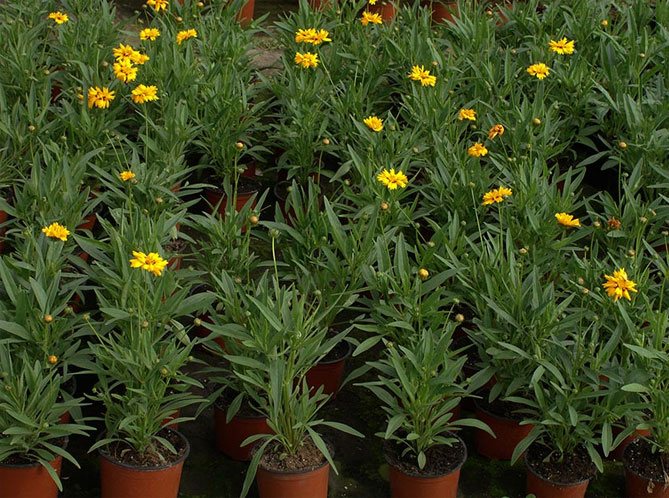

In the open field, cultivation from seeds is also possible in warm regions and the middle lane. Seeds are sown in the second decade of May. Flowering when sown outdoors will start later than when grown from seedlings.
Propagation of coreopsis by cuttings
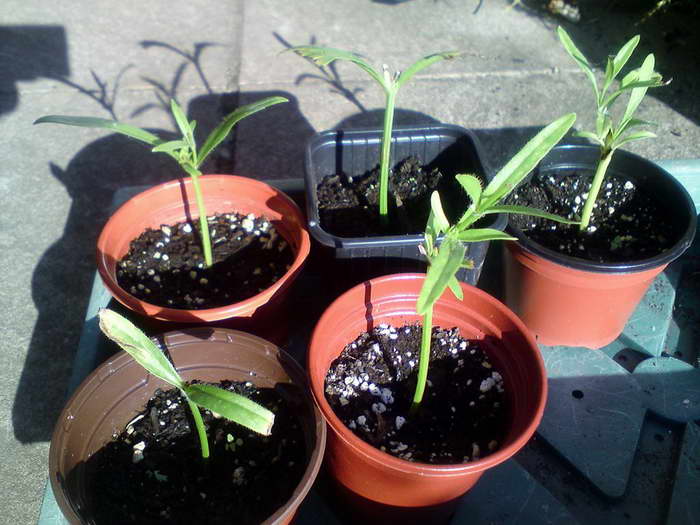

How to cut coreopsis photos
- Root stem cuttings in spring or summer in containers with loose soil.
- For cutting, cut the shoot into pieces with one internode at the top.
- Remove the leaves from the bottom, deepen the cuttings 2-4 cm into the soil, cover with a jar or plastic bottle.
- Provide partial shade and regular watering, ventilate.
- Transplant the rooted stalk in the spring to a place of constant growth.
Diseases and pests
Coreopsis do not get sick much and are rarely invaded by pests, so caring for plants is not difficult.
Fungal diseases that attack coreopsis:
- Downy mildew (Plasmopara halstedii) - white coating on the underside of the leaf;
- Powdery mildew (Erysiphae cichoracearum) - white bloom on the leaf surface, later darkening;
- Spot or septoria (Septoria coreopsidis, Cercospora coreopsidis) - brown spots on the lower leaves.
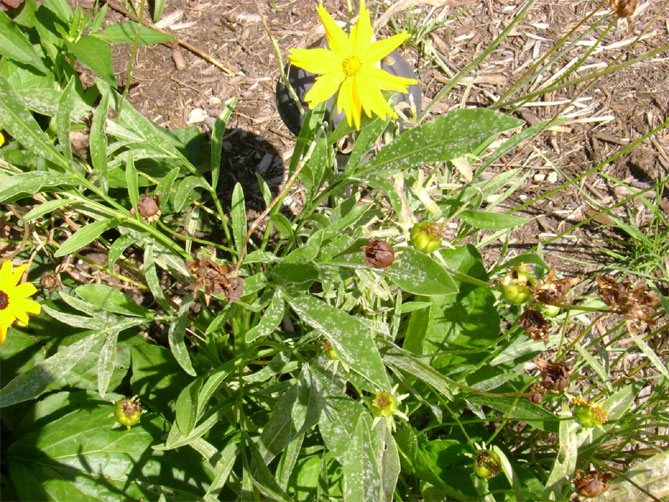

Pests attacking the plant:
- The main enemy is aphids. Colonies of pests can be found on the plant in spring. These millimeter insects can be green, yellow, black, brown. You can fight with insecticides or spraying with soapy water. The natural enemy of aphids is the ladybug.
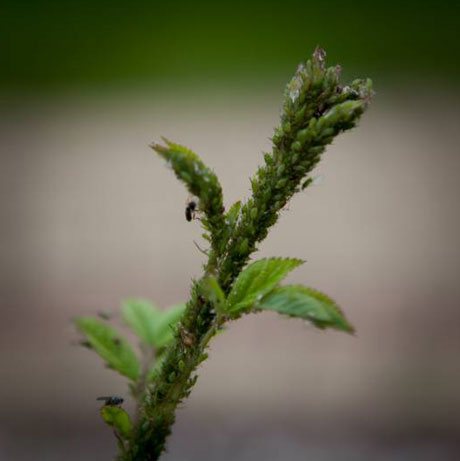

- The leaf fly (Chromatomyia horticola) is a miniature dipteran fly. Females pierce the surface of the leaf, the larvae feed inside, forming corridors, the so-called mines.
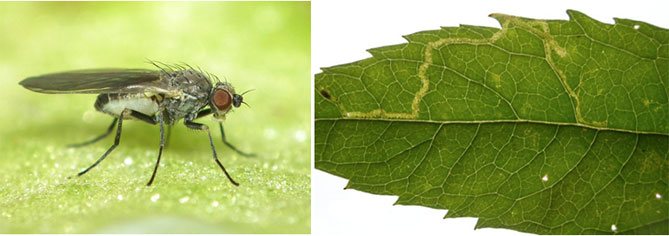

Coreopsis flower pests
If fusarium or rust appears on the stems and leaves, that is, brown spots, the damaged areas are immediately removed and the plant is treated with a fungicide. It could be Bordeaux mixture, Alirin.
When spotting appears, it is better to get rid of the bush and process the place where it was.
To combat aphids (the most common pest for coreopsis), insecticides Spark, Karate are used.
Planting and caring for perennial Coreopsis
Application in landscape design
Coreopsis is very easy to grow, and the bushes do not require too much maintenance. They bloom with beautiful flowers in warm yellow tones. The plant is ideal for planting in rural, rustic and naturalistic gardens.
They can be grown on perennial flower beds, and the bushes will be an interesting addition to summer flower arrangements.
Depending on the height of the plant, different varieties can be used as follows:
- undersized varieties (15-30 cm high) are great for rocky gardens, rock gardens, rockeries, flower beds;
- tall varieties (about 80 cm) should be planted at the back of the bed so that they do not cover smaller plants.


The Parisian beauty is also suitable for a cut flower. These perennials bloom all summer long, which creates an idyllic, festive atmosphere in the garden.
What is needed for life
The flower is beautiful not with the luxurious richness of the decoration, but with simple grace. It blooms in July and even in cold weather, when most of the flora are already "sleeping", it continues to delight with bright golden double inflorescences.
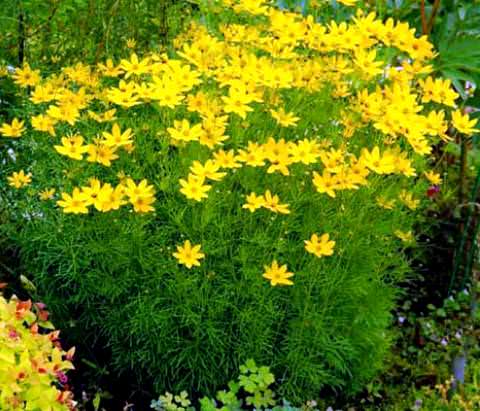

Due to its amazing endurance, whorled and large-flowered coreopsis, as well as other varieties, have become favorites of gardeners. A sprawling handsome man will need "personal space" - about 30-60 centimeters of free area around the bush. It easily adapts to growing conditions.
For staying under the sun, it will thank you with abundant flowering, in partial shade it will grow not very high, but it will also adapt. As for the soil, the plant is indifferent to the acidity. Its nutritional properties and moisture content are important.
Perennial coreopsis: combination with other plants
Perennial coreopsis become good neighbors for other inhabitants of the flower garden. They do not behave aggressively towards other plants, do not pretend to grow in the open field to foreign territory.
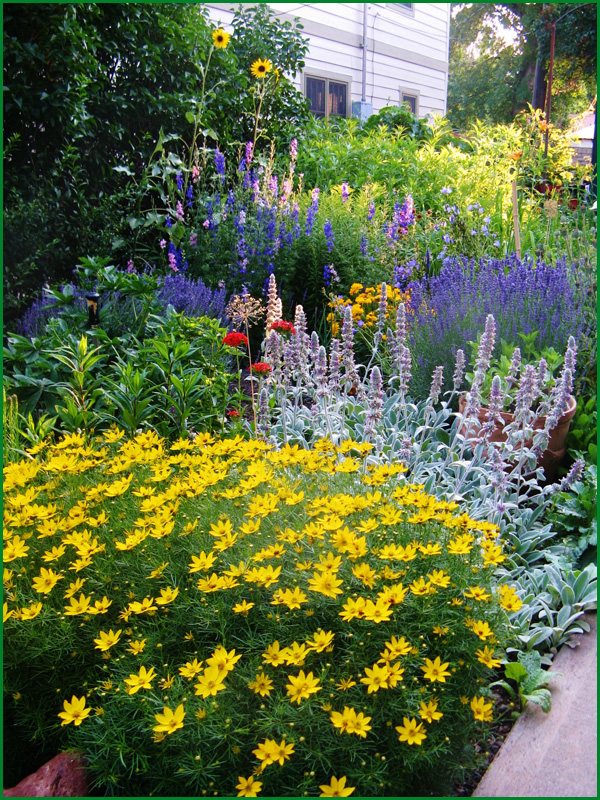

Coreopsis in landscape design
In addition, growing a number of tall specimens will not harm those flowers that love sunlight - coreopsis has thin stems and narrow foliage, so it does not shade close neighbors too much.
Advice.To make the flower bed bright, combine coreopsis with expressively blooming delphiniums, lilies. A joint planting in the open field with ground cover decorative deciduous plants looks good.
Description of perennial species Coreopsis
Arabis perennial - how to grow and care
Perennial varieties are most popular with gardeners because of their ease of care. The pale yellow, orange, light lilac and pink-red tones of these flowers can be enjoyed for several years, starting in June and ending with the first frost.
Whorled
Coreopsis verticulata lives and blooms for about 6 years, being in one place. The bushy plant has thick, light green leaves that retain their color until they freeze.
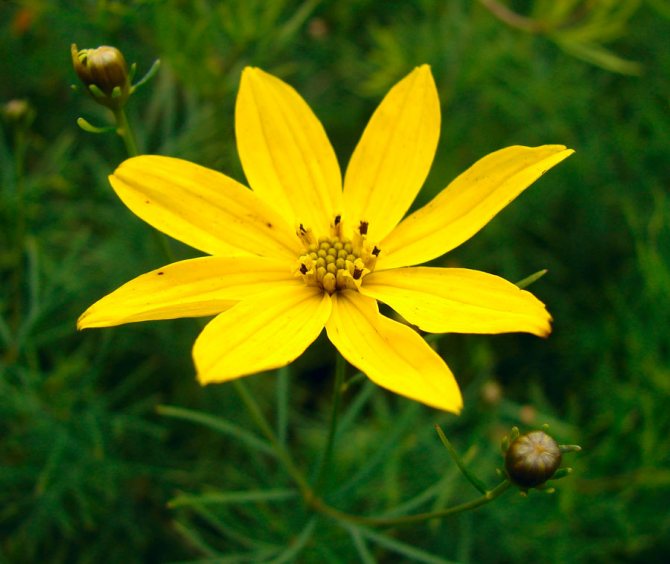

Coreopsis whorled
The flowers of Coreopsis verticillata resemble many stars of yellow, pinkish-purple, burgundy-red shades against a background of lush greenery.
Large-flowered
This Coreopsis is called grandiflora in Latin and is characterized by large flowers on powerful, straight stems. The leaves are arranged in pairs, opposite each other, have a feathery shape. Inflorescences are yellow in color, which ranges from lighter on ligulate flowers to darker on tubular central flowers.
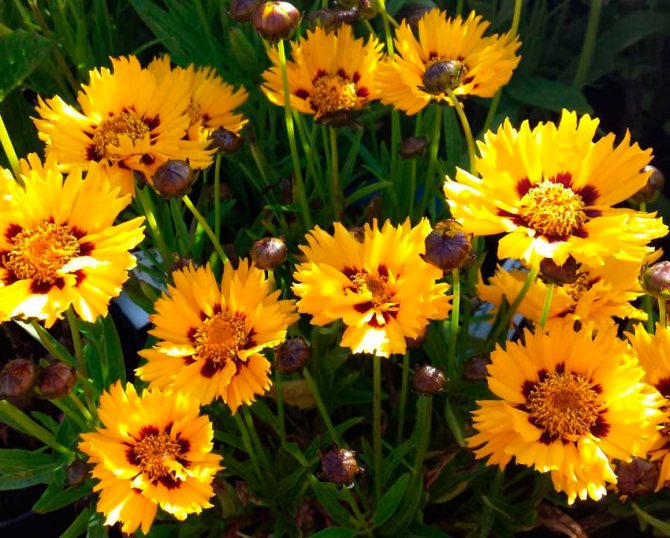

Coreopsis grandiflora
The beginning of flowering is July. It is recommended to plant a new bush of large-flowered coreopsis once every three years.
Lanceolate
This type of plant owes its name to the appearance of the leaves. In the lanceolate coreopsis, they are narrow, long and pointed, densely growing near the surface of the earth, almost not rising upward.
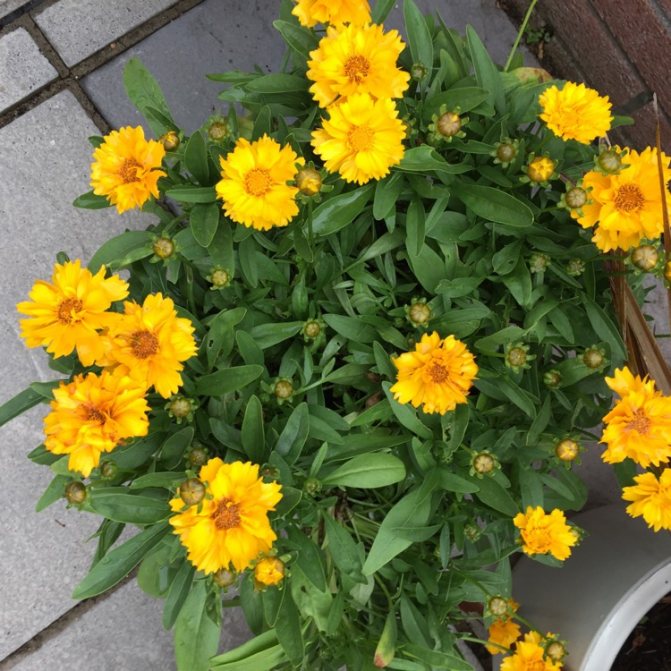

Coreopsis lanceolate
The height of the bush is 0.6 m. It is distinguished by large flowers of 5 cm in diameter, golden shades.
Terry
Terry coreopsis do not stand out as a separate species, they belong to lanceolate or large-flowered. On the inflorescences of such plants, reed radial flowers are arranged in several rows and have a fringe.
Variegated
In variegated coreopsis, not only flowers are beautiful, but also leaves. It is a variegated variety derived from grandiflorum with large flowers and dense foliage.
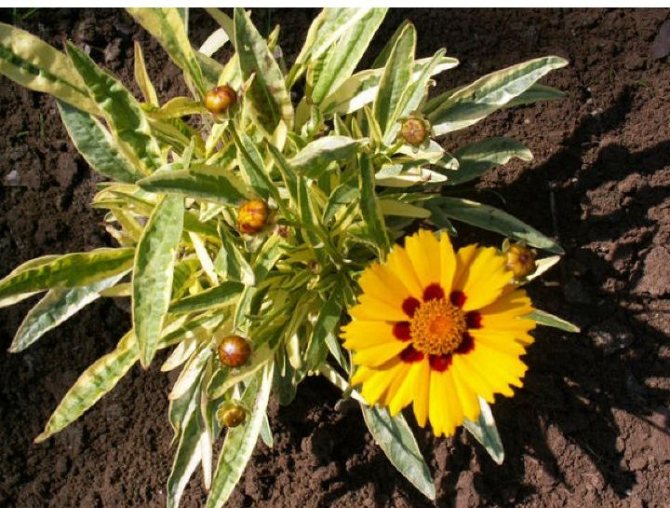

Variegated coreopsis
On the leaves, contrasting stripes of pale green and saturated green colors alternate.
Hybrid
Most cultivars belong to hybrid varieties, especially those with unusual bright colors of inflorescences and double petals. The most used species for crossing are Coreopsis grandiflora, Coreopsis rosea, Coreopsis verticilata.
Important! When propagated using seeds, hybrid varieties of perennial plants can lose varietal characteristics.
Pink
They are characterized by small inflorescences, not exceeding 2 cm in diameter, and a color that includes a wide palette of pink tones: from slightly pinkish, almost white, to deep red-violet.
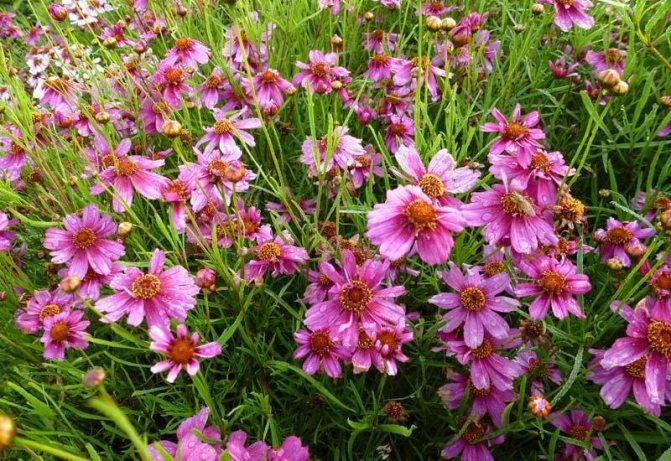

Coreopsis pink
The stem is relatively low (0.4 m), branched, with very narrow leaves, similar in shape to the foliage of cereals.
Reproduction by dividing the bush
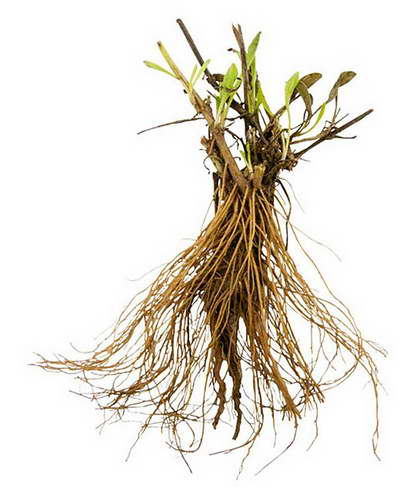

How to split a coreopsis bush photo
Perennial plants can be propagated vegetatively (bush division, cuttings).
- The division of the bush is carried out in the 4th year of growth in the spring (in regions with a cold climate) or in the fall in areas with warm winters.
- Carefully dig out the bush, divide it into parts, each of which should contain a rhizome and 2-3 growth buds, and plant it.
Florist reviews
Svetlana K.
Karyopsis sprouted well, grew slowly ... in the first summer only rosettes of leaves were formed ... wintered perfectly! (did not cover with anything) ... bloomed very luxuriantly in early June for the second and third summer ... flowering lasted until early August
Dominica
I bought lanceolate coreopsis in this form. Well, I am very pleased with him, the bush is easily divided, if you remove the faded buds, it blooms until frost.
Most popular varieties
All coreopsis varieties are of hybrid origin.
Earley Sunrise
Earley Sunrise Coreopsis has won several prestigious awards, including the Fleuroselect Gold Medal. This perennial plant produces many bright golden yellow flowers 5 cm in diameter, adorned with several rows of beautiful double petals. Dimensions - 45 cm high and 45-60 cm wide. Sunrise is one of the earliest coreopsis; inflorescences appear in some regions at the end of June.
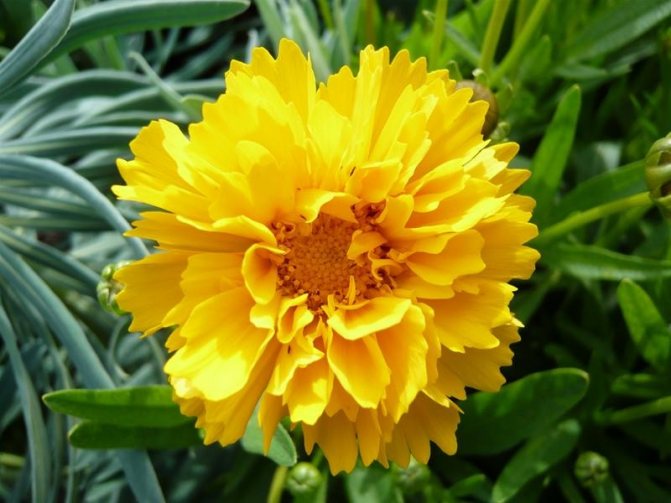

Coreopsis Earley Sunrise
Important! Cutting off the first wave of flowers in mid-summer encourages autumn re-blooming.
Golden globe
Another hybrid derived from Coreopsis grandiflora. Terry inflorescences form balls of outstanding beauty, color from golden to orange.
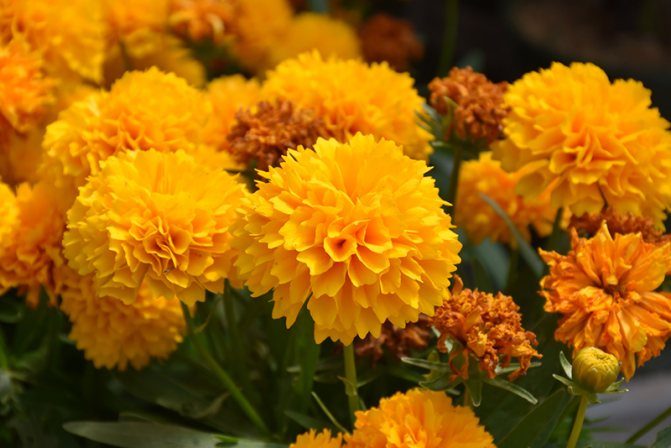

Coreopsis Golden globe
The leaves are pinnate, dissected on the upper part of the stem. Height - up to 1 m, flower diameter - up to 8 cm.
Sunbeam
This is a variety of yellow coreopsis with double inflorescences, not as lush as Golden ones, and with a more modest size (height - only up to 50 cm).
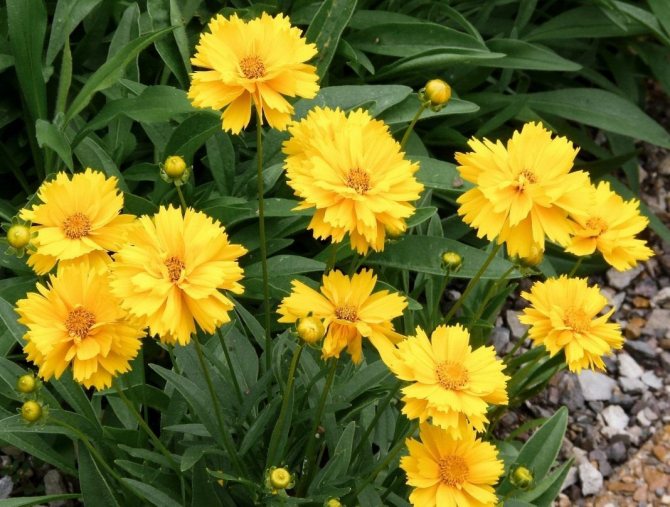

Coreopsis Sunbeam
However, the flowers are just as large.
Zagreb
A hybrid derived from Coreopsis verticilata. It has yellow flowers, similar to chamomile, 3-4 cm in diameter, the central disc of the inflorescence is darker. The filamentous leaves give the plant a fine structure and airy look. Zagreb is not very tall - only up to 45-50 cm.
Terry sun
Large-flowered variety with lush yellow double inflorescences (6 to 8 cm in diameter). It grows up to 0.8 m. It has good resistance to frost and drought.
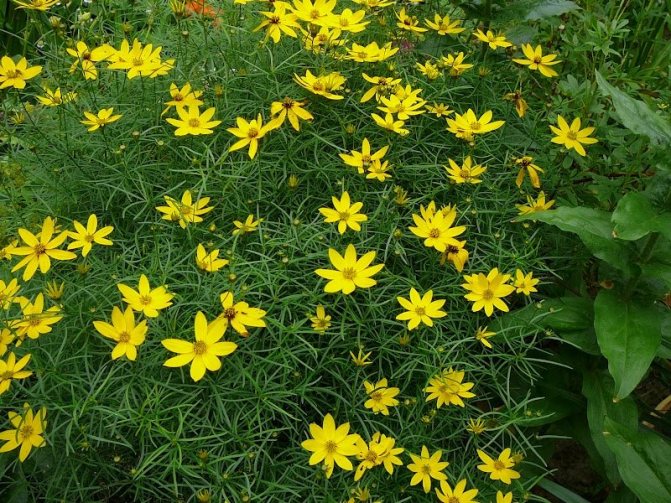

Coreopsis Terry sun
Refers to lanceolate.
Golden baby
One of the varieties very similar to Terry Sun and Sunbeam. The baby is named because of the small growth of the stems, only up to 0.4 m. But the large inflorescences are 6 cm in diameter.
Moonbeam
Comes from Coreopsis verticilata. Medium height (up to 60 cm) and wide enough (45-60 cm). Moonbeam has pale yellow buds with a 2.5 cm radius. Threadlike foliage on vertical stems adds delicate texture to landscape elements.
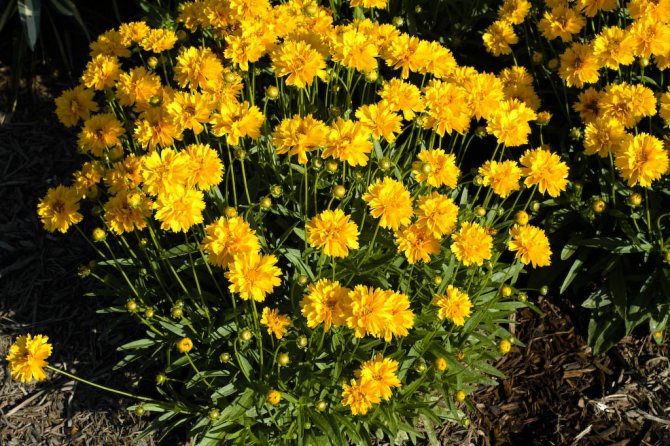

Coreopsis Moonbeam
It is very profitable to use it as an accent plant; it looks unusually impressive in case of mass plantings.
One year
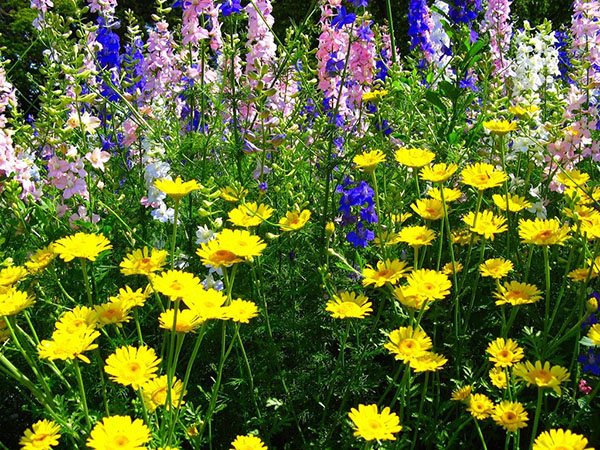

Unlike perennials, annual coreopsis (another name is "girl's eyes" or gypsy ") belongs to the dwarf group. At the same time, it blooms for 2 months longer than its “congeners”. The maximum height of the stem is 30-50 cm, and in undersized ones it is 15-25 cm. Of the 70 varieties of the Astrov family, only ten are cultivated.
If possible, the bush is cut off after flowering at a distance of 10-15 from the root collar. As a result, the stem discards the buds again. So you can enjoy the "sunny meadow" until late autumn.
Dyeing - natural dye
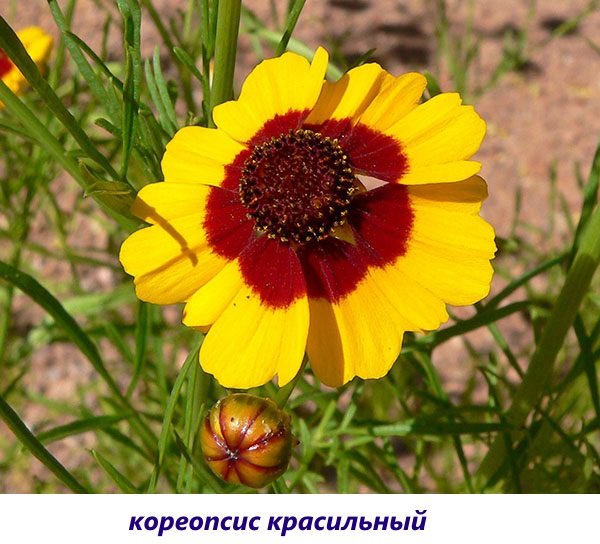

Before planting, the seeds of the girl's eye are soaked for a day in water, which acquires a yellow tint. This is one of the reasons why the plant got this name.
The water treatment helps to activate the growth of the branching stem. Although it is thin, it is still elastic enough to stretch up to 100 cm in height. Most of the leaves are concentrated in the root bundle. Then they are located alternately. Lush inflorescences of Coreopsis dyeing are presented in the form of lush baskets up to 5 cm in diameter. The petals are jagged and variegated. It can be either fiery yellow or dark red. It all depends on the variety:
- Crimson King. Showy carmine flowers with dark brown stripes / blotches. The bush grows up to 30 cm.
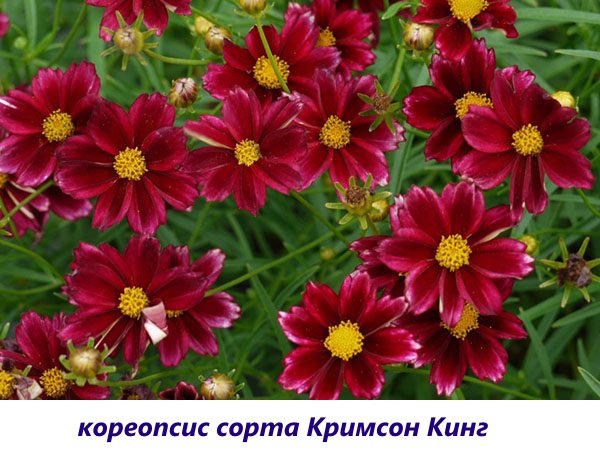

- Red Tiger or Bengal Tiger. Red spots with jagged edges appear on bright yellow petals. Plant height - 15-20 cm.
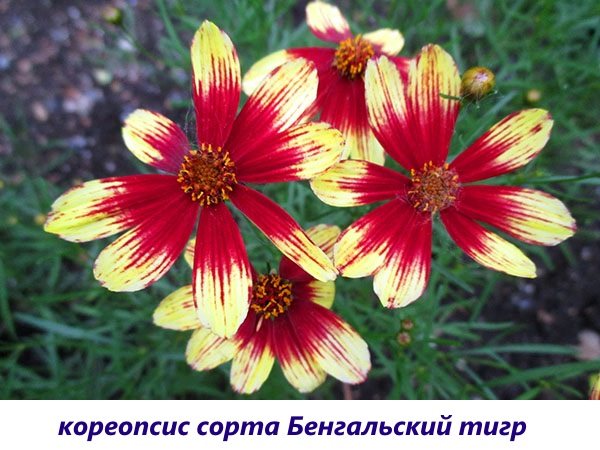

- Golden Severin. Large orange flowers (4 cm in diameter) adorn the undersized stems (20 cm).
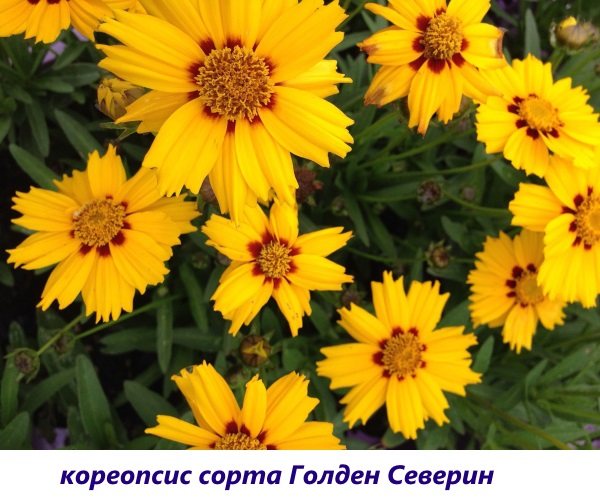

- Gold Teppih. The inflorescences are amber-yellow in color. The width of the umbrellas can be up to 5 cm.
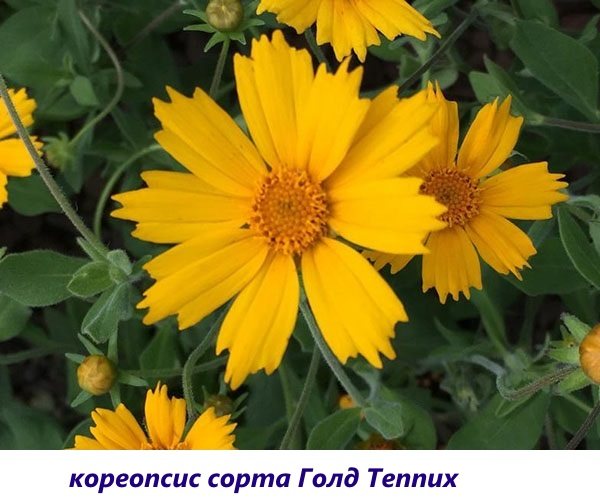

When growing coreopsis annual from seeds, special attention is paid to watering. The planting is irrigated only if the soil is completely dry.With regular and heavy rainfall, this is not necessary. The culture does not tolerate excess fertilizer. A small amount of compost is applied in spring or autumn during the period of exuberant flowering. Top dressing is carried out immediately after pruning.
In order for the bush to be lush and bloom densely, it is necessary to clean it of wilted / dry leaves, as well as shoots. By loosening the soil, the roots are saturated with a sufficient amount of oxygen.
Roulette is not Russian roulette at all
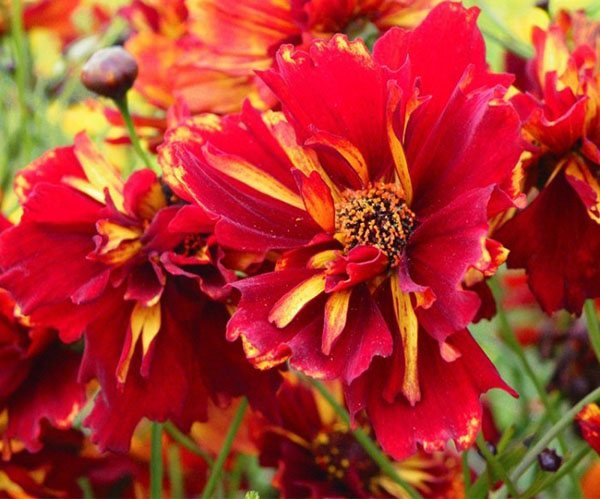

A special place in the garden is given to another type of dyeing annual - coreopsis "Roulette". He is dressed up and gorgeous, able to surprise even a sophisticated grower. Its petals are colored deep crimson. Their ribbed edges blend in exquisitely with any garden exterior. Moreover, refined umbrellas (diameter - 7 cm) have another row of thinned petals. These narrow yellow tendrils are the highlight of the Roulette variety. To create a corner of paradise, they are planted near them:
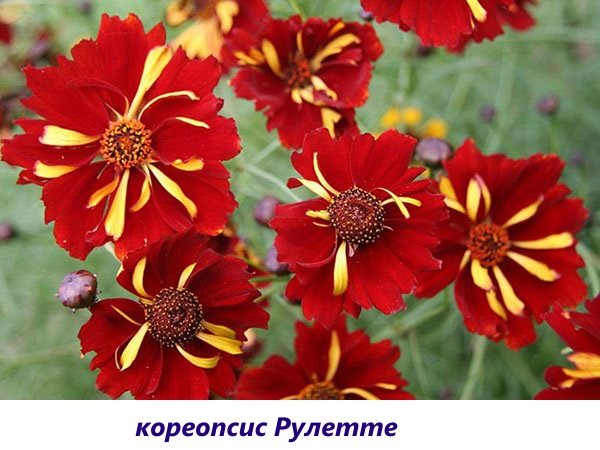

This assortment creates an original clearing, over which towering 50-centimeter "gypsies". A feature of this variety is that it grows fast enough, is not afraid of drought and cold snap. The best way to grow coreopsis rolls is from seeds. Sowing is carried out either in late autumn for the winter (October), or in the spring, as soon as the snow melts.
Planting depth is 0.5-1 cm. The first shoots in the form of 2-3 leaves must be thinned out.
Drummond - always in fashion
The height of the culture is 40-60 cm. Coreopsis flowers are distinguished by their large size and their yellow color with a shaggy burgundy core. It can be either wide or narrow. Ruffled tongue-shaped petals look elegant on graceful stems. The leaves of a pale green culture resemble the feathers of a firebird. The flowering period begins in July and lasts until October.
Growing coreopsis from seeds
Sowing seedlings
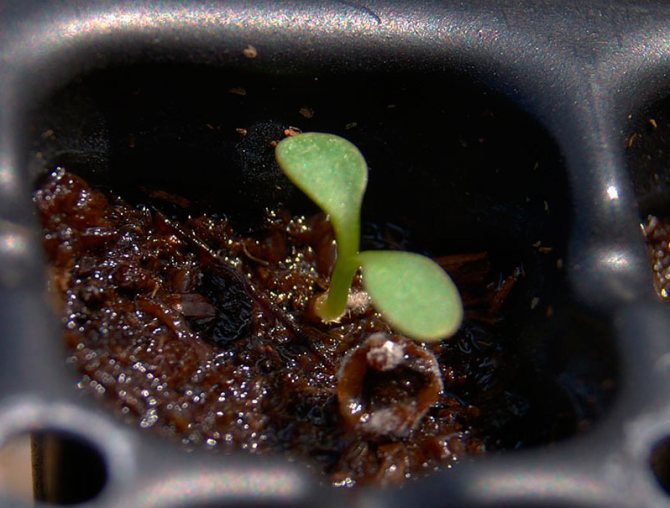

Planting and growing coreopsis is simple and easy. Annual species are sown in the greenhouse in mid-April, they can also be sown in open soil in May. As a rule, in species represented by perennials, the formation of inflorescences is observed only in the second year of growth. However, if you grow them through seedlings, then the bushes will bloom during the first season.
Sowing seeds for seedlings is carried out in the first days of March. Low drawers fill with fertile garden soil and moisturize it. Then, the seed material is evenly distributed over its surface, with the help of a plate it is slightly pressed into the substrate. From above, the container must be covered with glass (film), then it is transferred to a place where it is always warm and well-lit.
Growing seedlings
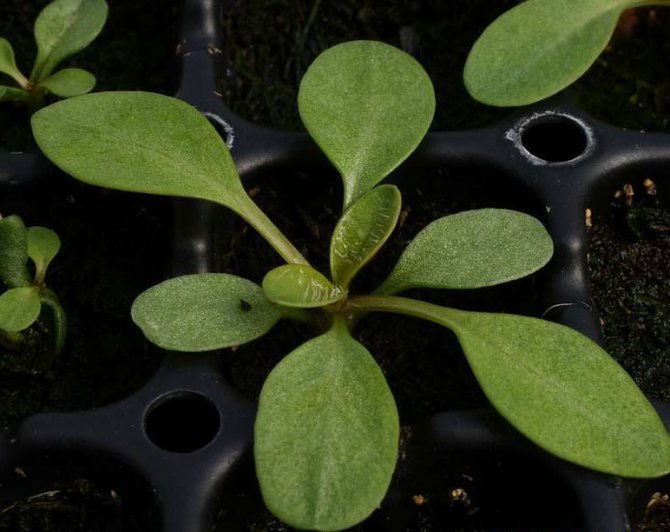

Crops need daily ventilation, during which accumulated condensate must be removed from the surface of the shelter. The seed material of such a plant has a very high germination capacity. The first seedlings should appear in about a week and a half. Shelters from the box are removed after the seedlings begin to appear in large quantities. If necessary, the seedlings need to be watered, after which the surface of the substrate is gently loosened.
Watering should be moderate and in no case should liquid stagnation in the soil mixture be allowed, as this can cause the development of such a fungal disease as black leg, which is detrimental to seedlings. A pick on individual cups is carried out after the first 2 true leaf plates are formed in the plants. You can also dive the bushes into a more spacious box, keeping a distance of about 20 mm between them, but in this case, after they reach a height of 10-12 centimeters, they will have to be replanted again.
Flower bed design
Coreopsis is used and loved for long-term flowering. It is placed in flower beds of continuous flowering perennials, varying in color shades.So, for example, red flowers can be placed with yellow sunflowers towering in the background, blue delphiniums, or next to a riot of lupines.
Coreopsis yellow eyes go well with daylilies and tall lilies. Some gardeners plant coreopsis in a bed of coniferous shrubs, using stones and ground cover plants.
Coreopsis fits into any group planting in the garden. Various combinations are used here, it all depends on the imagination.


